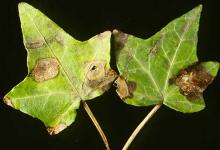Cause Two fungi have been reported on English ivy in Oregon and Washington: Colletotrichum trichellum, also known as anthracnose; and Phyllosticta concentrica. Rainy or wet conditions favor both fungi. Wounded leaves develop large spots when inoculated with anthracnose.
Symptoms Anthracnose is characterized as a necrotic leaf and stem spot. Generally, spots are less angular than those caused by bacterial leaf spot. Sometimes the stem becomes girdled, which results in the collapse and death of that portion of the vine.
Necrotic spots on leaves, which make the plant look ragged, characterize infection by Phyllosticta. Small, black, fruiting bodies (pycnidia) are produced in concentric circles within the leaf spot.
Cultural control
- Remove and destroy affected plant parts.
- Reduce or control overhead irrigation so leaves are not wet for extended periods.
- Use clean stock plants for propagation.
- The cultivars Gold Dust, Green Feather, and Shamrock may have useful resistance to this disease.
Chemical control Spray several times at 14-day intervals after first spots appear.
- Badge X2 at 1.5 to 2 lb/A. 24-hr reentry.
- Banner MAXX at 5 to 8 fl oz/100 gal water. Group 3 fungicide. 12-hr reentry.
- Camelot O at 0.5 to 2 gal/100 gal water. Group M1 fungicide. 4-hr reentry.
- Grotto at 0.5 to 2 gal/30 to 100 gal water/A. Group M1 fungicide. 4-hr reentry.
- Nu-Cop 50 DF at 1 lb/100 gal. Foliage discoloration has been noted. Group M1 fungicide. 48-hr reentry.
- Protect DF at 1 to 2 lb/100 gal water plus 2 to 4 oz spreader-sticker. Group M3 fungicides. 24-hr reentry.
Reference Kim, W.G., and Cho, W.D. 2001. Occurrence of Anthracnose on English Ivy Caused by Colletotrichum trichellum in Korea. Mycobiology 29:107-109.


